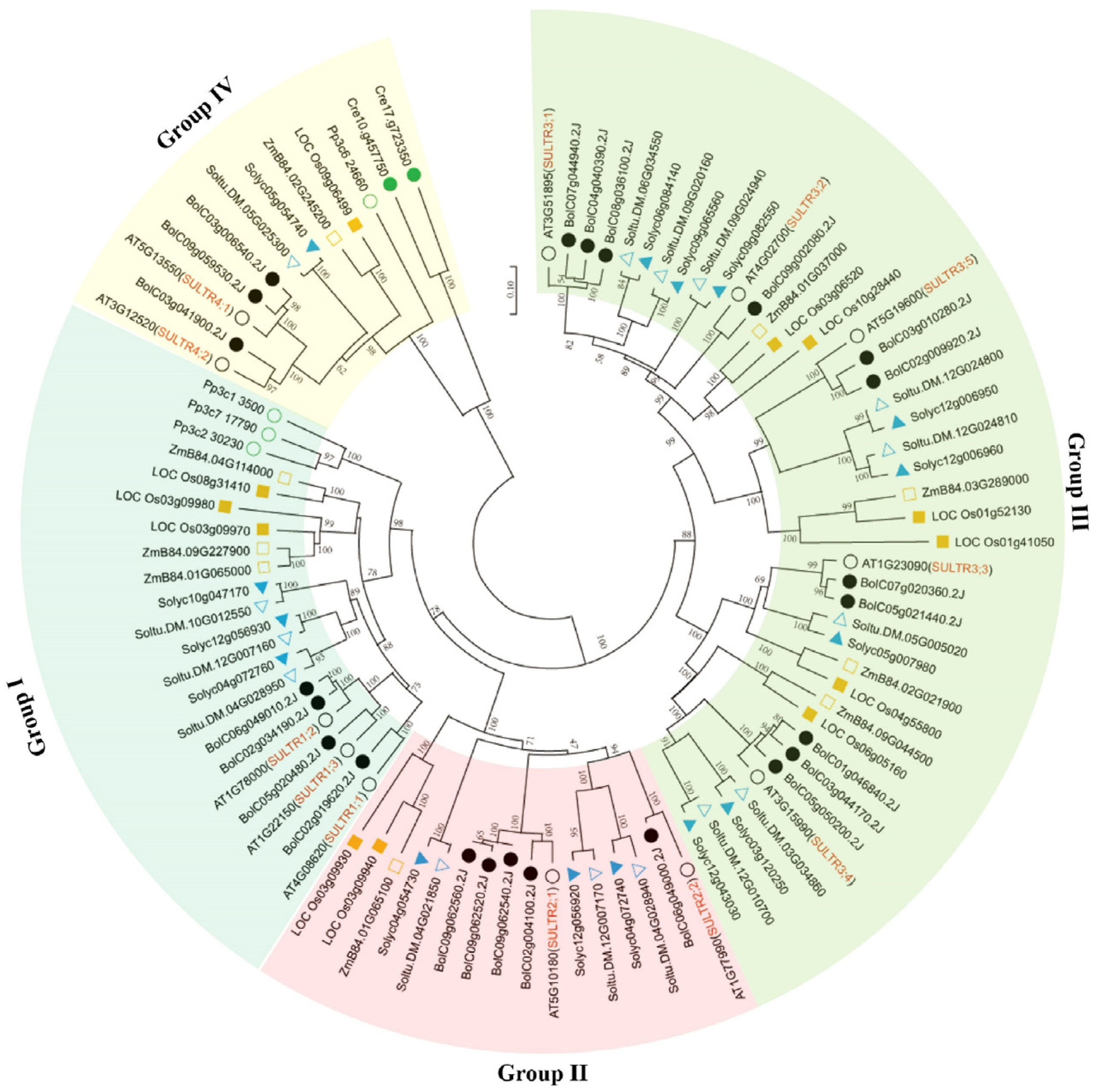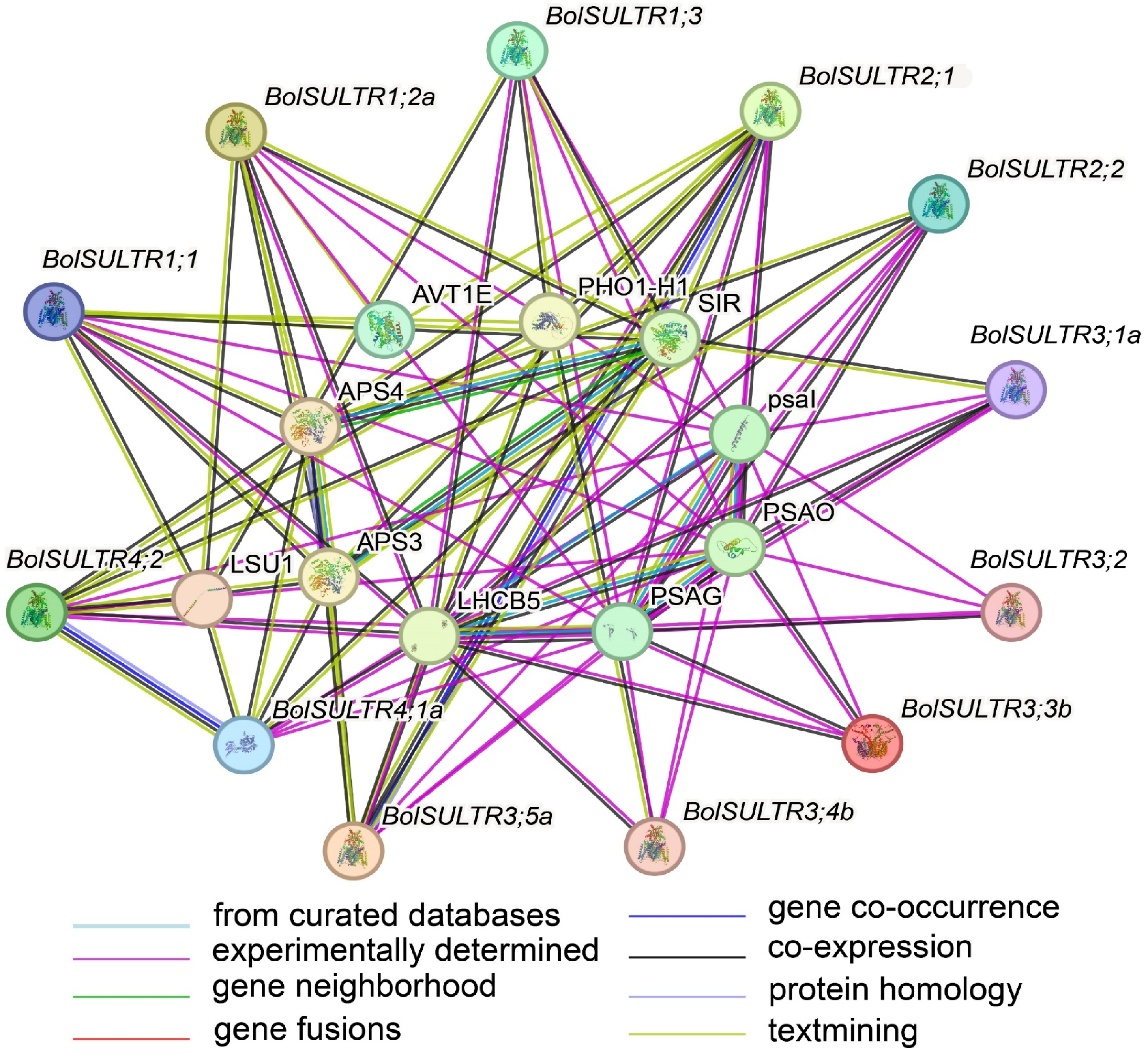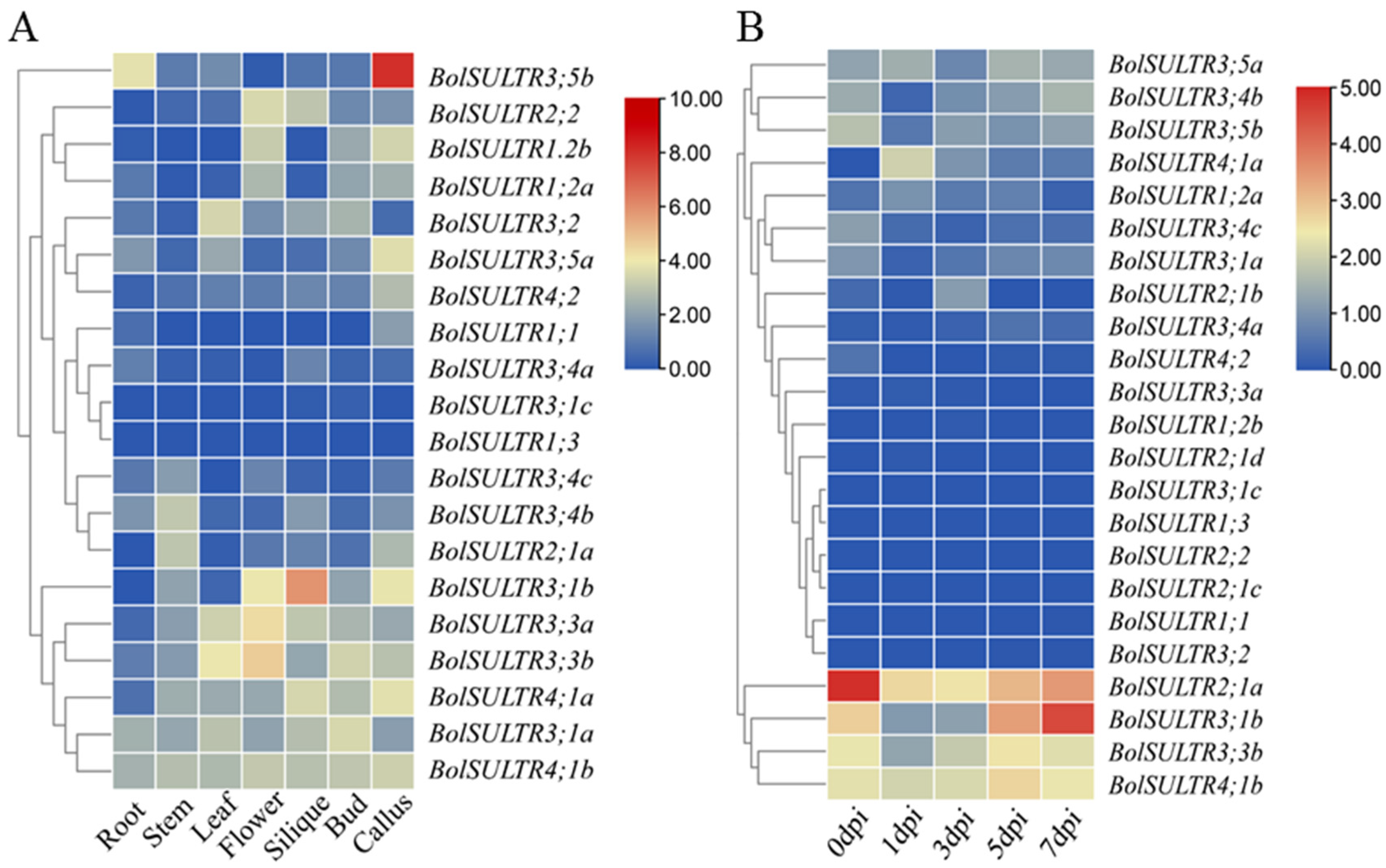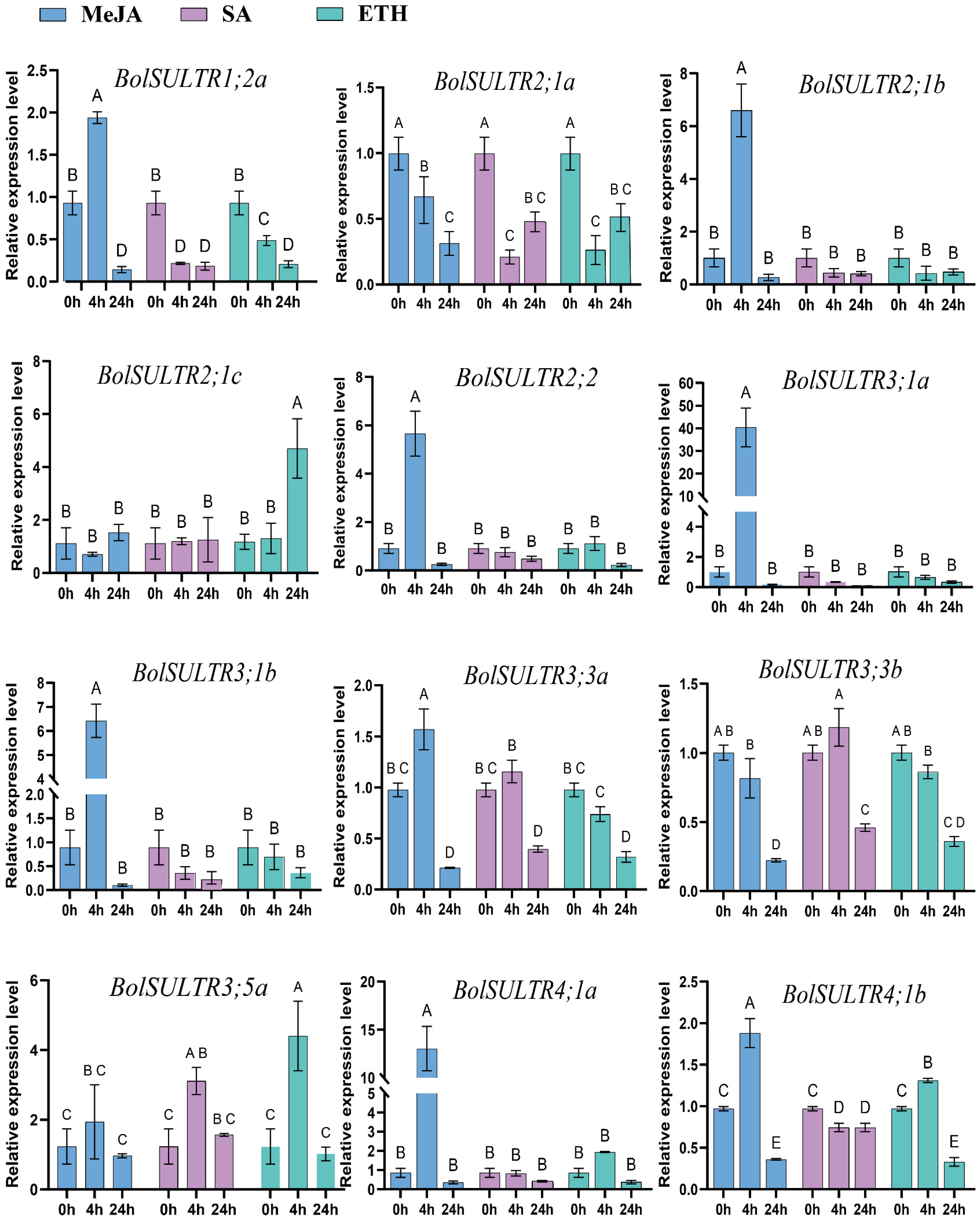Genome-Wide Identification of the Sulfate Transporter Gene Family Reveals That BolSULTR2;1 Regulates Plant Resistance to Alternaria brassicicola Through the Modulation of Glutathione Biosynthesis in Broccoli
Abstract
1. Introduction
2. Materials and Methods
2.1. Identification and Characterization of BolSULTRs
2.2. Phylogenetic Analysis, Classification, and Evolutionary Analysis
2.3. Chromosome Location and Homologous Gene Analysis
2.4. Analysis of Conserved Motifs and Gene Structures of the BolSULTRs
2.5. Promoter Cis-Acting Element
2.6. Protein–Protein Interaction Prediction
2.7. Plant Material and Treatment
2.8. Expression Patterns of BolSULTR Genes Based on RNA-Seq Data
2.9. Expression of SULTR Genes in Broccoli Treated with Different Phytohormones
2.10. RNA Extraction and qRT-PCR Analysis
2.11. Virus-Induced Gene Silencing (VIGS) of BolSULTR2;1
2.12. Measurements of ROS-Related Physiological and Biochemical Parameters
3. Results
3.1. Identification of SULTR Genes in Brassica Oleracea Broccoli
3.2. Phylogenetic Analysis of SULTR Gene Family
3.3. Conserved Domains of BolSULTRs
3.4. Analysis of Conserved Motifs and Gene Structure of BolSULTRs
3.5. The Chromosome Localization, Gene Duplication, Ka/Ks, and Synteny Analysis
3.6. Analysis of the Promoter Region of the BolSULTRs
3.7. BolSULTR Interaction Prediction
3.8. Expression Patterns of the BolSULTR Genes
3.9. Expression of BolSULTR Genes Under the Phytohormone Treatments
3.10. Silencing of BolSULTR2;1 Resulted in Reduced Leaf Spot Stress
4. Discussion
4.1. The Paradox Between Genome Complexity and SULTR Copy Number in Broccoli
4.2. Group II and III SULTRs Might Represent Flowering-Plant-Specific Transporters Associated with Long-Distance Movement of Sulfate
4.3. BolSULTR2 Might Be Involved in Plant Defense Against Alternaria brassicicola (Ab), Presumably Through the Regulation of Glutathione Biosynthesis
5. Conclusions
Supplementary Materials
Author Contributions
Funding
Informed Consent Statement
Data Availability Statement
Acknowledgments
Conflicts of Interest
References
- Zenda, T.; Liu, S.; Dong, A.; Duan, H. Revisiting Sulphur—The Once Neglected Nutrient: It’s Roles in Plant Growth, Metabolism, Stress Tolerance and Crop Production. Agriculture 2021, 11, 626. [Google Scholar] [CrossRef]
- Ausma, T.; De Kok, L.J. Atmospheric H2S: Impact on Plant Functioning. Front. Plant Sci. 2019, 10, 743. [Google Scholar] [CrossRef]
- Buchner, P.; Stuiver, C.E.E.; Westerman, S.; Wirtz, M.; Hell, R.d.; Hawkesford, M.J.; De Kok, L.J. Regulation of Sulfate Uptake and Expression of Sulfate Transporter Genes in Brassica oleracea as Affected by Atmospheric H2S and Pedospheric Sulfate Nutrition. Plant Physiol. 2004, 136, 3396–3408. [Google Scholar] [CrossRef] [PubMed]
- Takahashi, H.; Buchner, P.; Yoshimoto, N.; Hawkesford, M.J.; Shiu, S.-H. Evolutionary Relationships and Functional Diversity of Plant Sulfate Transporters. Front. Plant Sci. 2012, 2, 119. [Google Scholar] [CrossRef]
- Mugford, S.G.; Yoshimoto, N.; Reichelt, M.; Wirtz, M.; Hill, L.; Mugford, S.T.; Nakazato, Y.; Noji, M.; Takahashi, H.; Kramell, R.; et al. Disruption of Adenosine-5′-Phosphosulfate Kinase in Arabidopsis Reduces Levels of Sulfated Secondary Metabolites. Plant Cell 2009, 21, 910–927. [Google Scholar] [CrossRef] [PubMed]
- Kopriva, S.; Calderwood, A.; Weckopp, S.C.; Koprivova, A. Plant Sulfur and Big Data. Plant Sci. 2015, 241, 1–10. [Google Scholar] [CrossRef]
- Saito, K. Sulfur Assimilatory Metabolism. The Long and Smelling Road. Plant Physiol. 2004, 136, 2443–2450. [Google Scholar] [CrossRef]
- Kopriva, S. Control of Sulphate Assimilation and Glutathione Synthesis: Interaction With N and C Metabolism. J. Exp. Bot. 2004, 55, 1831–1842. [Google Scholar] [CrossRef]
- Kopriva, S. Regulation of Sulfate Sssimilation in Arabidopsis and Beyond. Ann. Bot. 2006, 97, 479–495. [Google Scholar] [CrossRef]
- Shibagaki, N.; Grossman, A.R. Binding of Cysteine Synthase to the STAS Domain of Sulfate Transporter and Its Regulatory Consequences. J. Biol. Chem. 2010, 285, 25094–25102. [Google Scholar] [CrossRef]
- Wang, L.; Chen, K.; Zhou, M. Structure and Function of an Arabidopsis thaliana Sulfate Transporter. Nat. Commun. 2021, 12, 4455. [Google Scholar] [CrossRef] [PubMed]
- Hawkesford, M.J. Transporter Gene Families in Plants: The Sulphate Transporter Gene Family—Redundancy or Specialization? Physiol Plant. 2003, 117, 155–163. [Google Scholar] [CrossRef]
- Gigolashvili, T.; Kopriva, S. Transporters in plant sulfur metabolism. Front. Plant Sci. 2014, 5, 442. [Google Scholar] [CrossRef] [PubMed]
- Yoshimoto, N.; Takahashi, H.; Smith, F.W.; Yamaya, T.; Saito, K. Two Distinct High-Affinity Sulfate Transporters with Different Inducibilities Mediate Uptake of Sulfate in Arabidopsis Roots. Plant J. 2002, 29, 465–473. [Google Scholar] [CrossRef]
- Yoshimoto, N.; Inoue, E.; Saito, K.; Yamaya, T.; Takahashi, H. Phloem-Localizing Sulfate Transporter, Sultr1;3, Mediates Re-distribution of Sulfur From Source to Sink Organs in Arabidopsis. Plant Physiol. 2003, 131, 1511–1517. [Google Scholar] [CrossRef]
- Takahashi, H.; Watanabe-Takahashi, A.; Smith, F.W.; Blake-Kalff, M.; Hawkesford, M.J.; Saito, K. The Roles of Three Functional Sulphate Transporters Involved in Uptake and Translocation of Sulphate in Arabidopsis thaliana. Plant J. 2000, 23, 171–182. [Google Scholar] [CrossRef]
- Chen, Z.; Zhao, P.-X.; Miao, Z.-Q.; Qi, G.-F.; Wang, Z.; Yuan, Y.; Ahmad, N.; Cao, M.-J.; Hell, R.; Wirtz, M.; et al. SULTR3s Function in Chloroplast Sulfate Uptake and Affect ABA Biosynthesis and the Stress Response. Plant Physiol. 2019, 180, 593–604. [Google Scholar] [CrossRef]
- Cao, M.J.; Wang, Z.; Wirtz, M.; Hell, R.; Oliver, D.J.; Xiang, C.B. SULTR3;1 is a chloroplast-localized sulfate transporter in Arabidopsis thaliana. Plant J. 2013, 73, 607–616. [Google Scholar] [CrossRef]
- Kataoka, T.; Hayashi, N.; Yamaya, T.; Takahashi, H. Root-to-shoot Transport of Sulfate in Arabidopsis. Evidence for the Role of SULTR3;5 as a Component of Low-Affinity Sulfate Transport System in the Root Vasculature. Plant Physiol. 2004, 136, 4198–4204. [Google Scholar] [CrossRef]
- Kataoka, T.; Watanabe-Takahashi, A.; Hayashi, N.; Ohnishi, M.; Mimura, T.; Buchner, P.; Hawkesford, M.J.; Yamaya, T.; Takahashi, H. Vacuolar Sulfate Transporters Are Essential Determinants Controlling Internal Distribution of Sulfate in Arabidopsis. Plant Cell 2004, 16, 2693–2704. [Google Scholar] [CrossRef]
- Maruyama-Nakashita, A.; Inoue, E.; Watanabe-Takahashi, A.; Yamaya, T.; Takahashi, H. Transcriptome Profiling of Sulfur-Responsive Genes in Arabidopsis Reveals Global Effects of Sulfur Nutrition on Multiple Metabolic Pathways. Plant Physiol. 2003, 132, 597–605. [Google Scholar] [CrossRef]
- Liang, G.; Yang, F.; Yu, D. MicroRNA395 Mediates Regulation of Sulfate Accumulation and Allocation in Arabidopsis thaliana. Plant J. 2010, 62, 1046–1057. [Google Scholar] [CrossRef] [PubMed]
- Soudthedlath, K.; Nakamura, T.; Ushiwatari, T.; Fukazawa, J.; Osakabe, K.; Osakabe, Y.; Maruyama-Nakashita, A. SULTR2;1 Adjusts the Bolting Timing by Transporting Sulfate from Rosette Leaves to the Primary Stem. Plant Cell Physiol. 2024, 65, 770–780. [Google Scholar] [CrossRef] [PubMed]
- Takahashi, H. Regulation of Sulfate Transport and Assimilation in Plants. Int. Rev. Cell Mol. Biol. 2010, 281, 129–159. [Google Scholar] [CrossRef] [PubMed]
- Bachelet, F.; Sanchez, M.; Aimé, D.; Naudé, F.; Rossin, N.; Ourry, A.; Deulvot, C.; Le Signor, C.; Vernoud, V.; Neiers, F.; et al. The Vacuolar Sulfate Transporter PsSULTR4 is a Key Determinant of Seed Yield and Protein Composition in Pea. Plant J. 2024, 119, 2919–2936. [Google Scholar] [CrossRef]
- Dubousset, L.; Abdallah, M.; Desfeux, A.S.; Etienne, P.; Meuriot, F.; Hawkesford, M.J.; Gombert, J.; Ségura, R.; Bataillé, M.P.; Rezé, S.; et al. Remobilization of Leaf S Compounds and Senescence in Response to Restricted Sulphate Supply During the Vegetative Stage of Oilseed Rape are Affected by Mineral N Availability. J. Exp. Bot. 2009, 60, 3239–3253. [Google Scholar] [CrossRef]
- Liu, N.; Hu, M.; Liang, H.; Tong, J.; Xie, L.; Wang, B.; Ji, Y.; Han, B.; He, H.; Liu, M.; et al. Physiological, Transcriptomic, and Metabolic Analyses Reveal that Mild Salinity Improves the Growth, Nutrition, and Flavor properties of Hydroponic Chinese Chive (Allium tuberosum Rottler ex Spr). Front. Nutr. 2022, 9, 1000271. [Google Scholar] [CrossRef]
- Yang, Z.; Hui, S.; Lv, Y.; Zhang, M.; Chen, D.; Tian, J.; Zhang, H.; Liu, H.; Cao, J.; Xie, W.; et al. miR395-Regulated Sulfate Metabolism Exploits Pathogen Sensitivity to Sulfate to Boost Immunity in Rice. Mol. Plant 2022, 15, 671–688. [Google Scholar] [CrossRef]
- Gallardo, K.; Courty, P.E.; Le Signor, C.; Wipf, D.; Vernoud, V. Sulfate Transporters in the Plant’s Response to Drought and Salinity: Regulation and Possible Functions. Front. Plant Sci. 2014, 5, 580. [Google Scholar] [CrossRef]
- Cao, M.J.; Wang, Z.; Zhao, Q.; Mao, J.L.; Speiser, A.; Wirtz, M.; Hell, R.; Zhu, J.K.; Xiang, C.B. Sulfate Availability Affects ABA Levels and Germination Response to ABA and Salt Stress in Arabidopsis thaliana. Plant J. 2014, 77, 604–615. [Google Scholar] [CrossRef]
- Abdull Razis, A.F.; Noor, N.M. Cruciferous Vegetables: Dietary Phytochemicals for Cancer Prevention. Asian Pac. J. Cancer Prev. 2013, 14, 1565–1570. [Google Scholar] [CrossRef] [PubMed]
- Salehi, B.; Quispe, C.; Butnariu, M.; Sarac, I.; Marmouzi, I.; Kamle, M.; Tripathi, V.; Kumar, P.; Bouyahya, A.; Capanoglu, E.; et al. Phytotherapy and Food Applications from Brassica Genus. Phytother. Res. 2021, 35, 3590–3609. [Google Scholar] [CrossRef]
- Zhang, Q.; Branca, F.; Li, N.; Liu, N.; Ding, Y. Identification of Black Spot Resistance in Broccoli (Brassica oleracea L. var. italica) Germplasm Resources. Appl. Sci. 2024, 14, 2883. [Google Scholar] [CrossRef]
- Kumar, P.; Srivastava, D.K. Biotechnological Advancement in Genetic Improvement of Broccoli (Brassica oleracea L. var. italica), an Important Vegetable Crop. Biotechnol. Lett. 2016, 38, 1049–1063. [Google Scholar] [CrossRef]
- Cai, X.; Wu, J.; Liang, J.; Lin, R.; Zhang, K.; Cheng, F.; Wang, X. Improved Brassica oleracea JZS Assembly Reveals Significant Changing of LTR-RT Dynamics in Different Morphotypes. Theor. Appl. Genet. 2020, 133, 3187–3199. [Google Scholar] [CrossRef] [PubMed]
- Chen, C.; Chen, H.; Zhang, Y.; Thomas, H.R.; Frank, M.H.; He, Y.; Xia, R. TBtools: An Integrative Toolkit Developed for Interactive Analyses of Big Biological Data. Mol. Plant 2020, 13, 1194–1202. [Google Scholar] [CrossRef]
- Mistry, J.; Chuguransky, S.; Williams, L.; Qureshi, M.; Salazar, G.A.; Sonnhammer, E.L.L.; Tosatto, S.C.E.; Paladin, L.; Raj, S.; Richardson, L.J.; et al. Pfam: The Protein Families Database in 2021. Nucleic Acids Res. 2021, 49, D412–D419. [Google Scholar] [CrossRef]
- Marchler-Bauer, A.; Derbyshire, M.K.; Gonzales, N.R.; Lu, S.; Chitsaz, F.; Geer, L.Y.; Geer, R.C.; He, J.; Gwadz, M.; Hurwitz, D.I.; et al. CDD: NCBI’s Conserved Domain Database. Nucleic Acids Res. 2015, 43, D222–D226. [Google Scholar] [CrossRef]
- Finn, R.D.; Bateman, A.; Clements, J.; Coggill, P.; Eberhardt, R.Y.; Eddy, S.R.; Heger, A.; Hetherington, K.; Holm, L.; Mistry, J.; et al. Pfam: The Protein Families Database. Nucleic Acids Res. 2014, 42, D222–D230. [Google Scholar] [CrossRef]
- Duvaud, S.; Gabella, C.; Lisacek, F.; Stockinger, H.; Ioannidis, V.; Durinx, C. Expasy, the Swiss Bioinformatics Resource Portal, as Designed by its Users. Nucleic Acids Res. 2021, 49, W216–W227. [Google Scholar] [CrossRef]
- Newbigin, E.; Chou, K.-C.; Shen, H.-B. Plant-mPLoc: A Top-Down Strategy to Augment the Power for Predicting Plant Protein Subcellular Localization. PLoS ONE 2010, 5, e11335. [Google Scholar] [CrossRef]
- Kumar, S.; Stecher, G.; Li, M.; Knyaz, C.; Tamura, K.; Battistuzzi, F.U. MEGA X: Molecular Evolutionary Genetics Analysis across Computing Platforms. Mol. Biol. Evol. 2018, 35, 1547–1549. [Google Scholar] [CrossRef] [PubMed]
- Wang, Y.; Tang, H.; DeBarry, J.D.; Tan, X.; Li, J.; Wang, X.; Lee, T.-h.; Jin, H.; Marler, B.; Guo, H.; et al. MCScanX: A Toolkit for Detection and Evolutionary Analysis of Gene Synteny and Collinearity. Nucleic Acids Res. 2012, 40, e49. [Google Scholar] [CrossRef]
- Lescot, M.; Déhais, P.; Thijs, G.; Marchal, K.; Moreau, Y.; Van de Peer, Y.; Rouzé, P.; Rombauts, S. PlantCARE, a Database of Plant Cis-Acting Regulatory Elements and a Portal to Tools for in Silico Analysis of Promoter Sequences. Nucleic Acids Res. 2002, 30, 325–327. [Google Scholar] [CrossRef] [PubMed]
- Li, N.; Xie, L.; Hu, M.; Tong, J.; Wang, B.; Ji, Y.; Chen, J.; Liang, H.; Liu, W.; Liu, M.; et al. Effects of Blanching Cultivation on the Chemical Composition and Nutritional Quality of Chinese Chive. Food Chem. 2025, 464, 141824. [Google Scholar] [CrossRef]
- Lai, M.; Cheng, Z.; Xiao, L.; Klosterman, S.J.; Wang, Y. The bZip Transcription Factor VdMRTF1 is a Negative Regulator of Melanin Biosynthesis and Virulence in Verticillium dahliae. Microbiol. Spectr. 2022, 10, e02581-21. [Google Scholar] [CrossRef]
- Schnable, J.C.; Wang, X.; Pires, J.C.; Freeling, M. Escape from Preferential Retention Following Repeated Whole Genome Duplications in Plants. Front. Plant Sci. 2012, 3, 94. [Google Scholar] [CrossRef]
- Rahman, M.M.; Ghosh, P.K.; Akter, M.; Al Noor, M.M.; Rahman, M.A.; Keya, S.S.; Roni, M.S.; Biswas, A.; Bulle, M. Green Vanguards: Harnessing the Power of Plant Antioxidants, Signal Catalysts, and Genetic Engineering to Combat Reactive Oxygen Species under Multiple Abiotic Stresses. Plant Stress 2024, 13, 100547. [Google Scholar] [CrossRef]
- Roychowdhury, R.; Hada, A.; Biswas, S.; Mishra, S.; Prusty, M.R.; Das, S.P.; Ray, S.; Kumar, A.; Sarker, U. Jasmonic Acid (JA) in Plant Immune Response: Unravelling Complex Molecular Mechanisms and Networking of Defence Signalling Against Pathogens. J. Plant Growth Regul. 2024, 44, 89–114. [Google Scholar] [CrossRef]
- Uji, Y.; Kashihara, K.; Kiyama, H.; Mochizuki, S.; Akimitsu, K.; Gomi, K. Jasmonic Acid-induced VQ-motif-Containing Protein OsVQ13 Influences the OsWRKY45 Signaling Pathway and Grain Size by Associating with OsMPK6 in Rice. Int. J. Mol. Sci. 2019, 20, 2917. [Google Scholar] [CrossRef]
- Wang, Z.; Tan, X.; Zhang, Z.; Gu, S.; Li, G.; Shi, H. Defense to Sclerotinia Sclerotiorum in Oilseed Rape is Associated with the Sequential Activations of Salicylic Acid Signaling and Jasmonic Acid Signaling. Plant Sci. 2012, 184, 75–82. [Google Scholar] [CrossRef]
- Capaldi, F.R.; Gratão, P.L.; Reis, A.R.; Lima, L.W.; Azevedo, R.A. Sulfur Metabolism and Stress Defense Responses in Plants. Trop. Plant Biol. 2015, 8, 60–73. [Google Scholar] [CrossRef]
- Leustek, T.; Saito, K. Sulfate Transport and Assimilation in Plants. Plant Physiol. 1999, 120, 637–644. [Google Scholar] [CrossRef] [PubMed]
- Kopriva, S.; Takahashi, H. Sulfate Transport Systems in Plants: Functional Diversity and Molecular Mechanisms Underlying Regulatory Coordination. J. Exp. Bot. 2019, 70, 4075–4087. [Google Scholar] [CrossRef]
- Kumar, S.; Asif, M.H.; Chakrabarty, D.; Tripathi, R.D.; Trivedi, P.K. Differential Expression and Alternative Splicing of Rice Sulphate Transporter Family Members Regulate Sulphur Status during Plant Growth, Development and Stress Conditions. Funct. Integr. Genom. 2011, 11, 259–273. [Google Scholar] [CrossRef]
- Huang, Q.; Wang, M.; Xia, Z. The SULTR Gene Family in Maize (Zea mays L.): Gene Cloning and Expression Analyses under Sulfate Starvation and Abiotic Stress. J. Plant Physiol. 2018, 220, 24–33. [Google Scholar] [CrossRef]
- Yang, X.; Liao, X.; Yu, L.; Rao, S.; Chen, Q.; Zhu, Z.; Cong, X.; Zhang, W.; Ye, J.; Cheng, S.; et al. Combined Metabolome and Transcriptome Analysis Reveal the Mechanism of Selenate Influence on the Growth and Quality of Cabbage (Brassica oleracea var. capitata L.). Food Res. Int. 2022, 156, 111135. [Google Scholar] [CrossRef]
- Clark, J.W.; Donoghue, P.C.J. Whole-Genome Duplication and Plant Macroevolution. Trends Plant Sci. 2018, 23, 933–945. [Google Scholar] [CrossRef]
- Liang, Z.; Schnable, J.C. Functional Divergence between Subgenomes and Gene Pairs after Whole Genome Duplications. Mol. Plant 2018, 11, 388–397. [Google Scholar] [CrossRef]
- De Smet, R.; Adams, K.L.; Vandepoele, K.; Van Montagu, M.C.E.; Maere, S.; Van de Peer, Y. Convergent Gene Loss Following Gene and Genome Duplications Creates Single-Copy Families in Flowering Plants. Proc. Natl. Acad. Sci. USA 2013, 110, 2898–2903. [Google Scholar] [CrossRef]
- Kruse, C.; Haas, F.H.; Jost, R.; Reiser, B.; Reichelt, M.; Wirtz, M.; Gershenzon, J.; Schnug, E.; Hell, R. Improved Sulfur Nutrition Provides the Basis for Enhanced Production of Sulfur-Containing Defense Compounds in Arabidopsis thaliana upon Inoculation with Alternaria brassicicola. J. Plant Physiol. 2012, 169, 740–743. [Google Scholar] [CrossRef]
- Vatansever, R.; Koc, I.; Ozyigit, I.I.; Sen, U.; Uras, M.E.; Anjum, N.A.; Pereira, E.; Filiz, E. Genome-wide Identification and Expression Analysis of Sulfate Transporter (SULTR) Genes in Potato (Solanum tuberosum L.). Planta 2016, 244, 1167–1183. [Google Scholar] [CrossRef] [PubMed]
- Salih, H.; Bai, W.; Liang, Y.; Yang, R.; Zhao, M.; Muhammd, S.M.; Zhang, D.; Li, X. ROS Scavenging Enzyme-encoding Genes Play Important Roles in the Desert Moss Syntrichia Caninervis Response to Extreme Cold and Desiccation Stresses. Int. J. Biol. Macromol. 2024, 254, 127778. [Google Scholar] [CrossRef] [PubMed]
- Ito, T.; Ohkama-Ohtsu, N.; Marsolais, F. Degradation of Glutathione and Glutathione Conjugates in Plants. J. Exp. Bot. 2023, 74, 3313–3327. [Google Scholar] [CrossRef] [PubMed]
- Singh, D. Juggling with Reactive Oxygen Species and Antioxidant Defense System—A Coping Mechanism under Salt Stress. Plant Stress 2022, 5, 100093. [Google Scholar] [CrossRef]
- Li, S. Novel Insight into Functions of Ascorbate Peroxidase in Higher Plants: More than a Simple Antioxidant Enzyme. Redox Biol. 2023, 64, 102789. [Google Scholar] [CrossRef]








| Gene_Name a | Gene_ID b | Putative Proteins’ Physical and Chemical Parameters c | Predicted Location(s) d | ||||
|---|---|---|---|---|---|---|---|
| Peptide Length (aa) | MW (kDa) | pI | Instability Index | GRAVY | |||
| BolSULTR1.2b | BolC02g034190.2J | 652 | 71.64 | 9.12 | 33.97 | 0.410 | Cell membrane |
| BolSULTR1;1 | BolC02g019620.2J | 648 | 70.59 | 9.12 | 35.14 | 0.406 | Cell membrane |
| BolSULTR1;2a | BolC06g049010.2J | 655 | 71.84 | 8.81 | 34.81 | 0.401 | Cell membrane |
| BolSULTR1;3 | BolC05g020480.2J | 683 | 74.96 | 9.22 | 34.71 | 0.456 | Cell membrane |
| BolSULTR2;1a | BolC02g004100.2J | 677 | 73.97 | 9.04 | 37.58 | 0.427 | Cell membrane |
| BolSULTR2;1b | BolC09g062520.2J | 686 | 75.39 | 8.86 | 39.45 | 0.414 | Cell membrane |
| BolSULTR2;1c | BolC09g062540.2J | 629 | 68.97 | 8.21 | 37.44 | 0.473 | Cell membrane |
| BolSULTR2;1d | BolC09g062560.2J | 624 | 68.22 | 8.54 | 36.2 | 0.489 | Cell membrane |
| BolSULTR2;2 | BolC06g049000.2J | 471 | 51.29 | 9.43 | 30.44 | 0.586 | Cell membrane |
| BolSULTR3;1a | BolC07g044940.2J | 759 | 83.77 | 8.99 | 33.55 | 0.263 | Cell membrane |
| BolSULTR3;1b | BolC08g036100.2J | 876 | 97.30 | 5.96 | 40.41 | −0.093 | Cell membrane, nucleus |
| BolSULTR3;1c | BolC04g040390.2J | 390 | 43.33 | 8.5 | 40.64 | 0.407 | Cell membrane |
| BolSULTR3;2 | BolC09g002080.2J | 650 | 71.74 | 8.81 | 42.51 | 0.438 | Cell membrane |
| BolSULTR3;3a | BolC07g020360.2J | 656 | 72.22 | 9.1 | 35.68 | 0.461 | Cell membrane |
| BolSULTR3;3b | BolC05g021440.2J | 632 | 69.42 | 9.3 | 36.37 | 0.425 | Cell membrane |
| BolSULTR3;4a | BolC05g050200.2J | 656 | 71.95 | 9.51 | 40.83 | 0.407 | Cell membrane |
| BolSULTR3;4b | BolC01g046840.2J | 660 | 72.09 | 9.63 | 39.27 | 0.409 | Cell membrane |
| BolSULTR3;4c | BolC03g044170.2J | 653 | 71.60 | 9.54 | 37.55 | 0.44 | Cell membrane |
| BolSULTR3;5a | BolC03g010280.2J | 636 | 70.53 | 8.48 | 35.85 | 0.442 | Cell membrane |
| BolSULTR3;5b | BolC02g009920.2J | 634 | 70.38 | 8.85 | 32.21 | 0.447 | Cell membrane |
| BolSULTR4;1a | BolC03g006540.2J | 692 | 75.88 | 8.64 | 45.62 | 0.324 | Chloroplast |
| BolSULTR4;1b | BolC09g059530.2J | 693 | 75.89 | 8.34 | 43.5 | 0.288 | Chloroplast |
| BolSULTR4;2 | BolC03g041900.2J | 989 | 108.00 | 6.03 | 39.73 | 0.138 | Chloroplast, vacuole |
Disclaimer/Publisher’s Note: The statements, opinions and data contained in all publications are solely those of the individual author(s) and contributor(s) and not of MDPI and/or the editor(s). MDPI and/or the editor(s) disclaim responsibility for any injury to people or property resulting from any ideas, methods, instructions or products referred to in the content. |
© 2025 by the authors. Licensee MDPI, Basel, Switzerland. This article is an open access article distributed under the terms and conditions of the Creative Commons Attribution (CC BY) license (https://creativecommons.org/licenses/by/4.0/).
Share and Cite
Wu, G.; Ding, Y.; Li, N.; Zhang, H.; Liu, N. Genome-Wide Identification of the Sulfate Transporter Gene Family Reveals That BolSULTR2;1 Regulates Plant Resistance to Alternaria brassicicola Through the Modulation of Glutathione Biosynthesis in Broccoli. Antioxidants 2025, 14, 496. https://doi.org/10.3390/antiox14040496
Wu G, Ding Y, Li N, Zhang H, Liu N. Genome-Wide Identification of the Sulfate Transporter Gene Family Reveals That BolSULTR2;1 Regulates Plant Resistance to Alternaria brassicicola Through the Modulation of Glutathione Biosynthesis in Broccoli. Antioxidants. 2025; 14(4):496. https://doi.org/10.3390/antiox14040496
Chicago/Turabian StyleWu, Guize, Yunhua Ding, Ning Li, Hongji Zhang, and Ning Liu. 2025. "Genome-Wide Identification of the Sulfate Transporter Gene Family Reveals That BolSULTR2;1 Regulates Plant Resistance to Alternaria brassicicola Through the Modulation of Glutathione Biosynthesis in Broccoli" Antioxidants 14, no. 4: 496. https://doi.org/10.3390/antiox14040496
APA StyleWu, G., Ding, Y., Li, N., Zhang, H., & Liu, N. (2025). Genome-Wide Identification of the Sulfate Transporter Gene Family Reveals That BolSULTR2;1 Regulates Plant Resistance to Alternaria brassicicola Through the Modulation of Glutathione Biosynthesis in Broccoli. Antioxidants, 14(4), 496. https://doi.org/10.3390/antiox14040496




